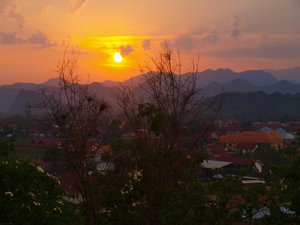Advertisement

 Luang Prabang
Luang Prabang
Sunset over Luang PrabangThere seems to be a correlation between the number of steps we have to climb to reach the village, the Buddah, the temple, the cave, our hotel, breakfast, etc., with the number of degrees celsius it is outside.
After plodding up stairs to various temples our first morning in Luang Prabang, then stopping for a welcome lunch, we asked what our afternoon agenda was. "Wat Xieng Thong temple," said our guide. We exchanged glances. "Is there anything special about this temple?" asked Keith. As if suspecting that we were about to say we'd skip this temple, our guide replied "this is the most important temple." Of course it was. It was one of the oldest because it had survived invading armies.
Back at our hotel we indulged ourselves with a well-earned massage and enjoyed the lovely view from our room of the red sun dropping behind the lush, limestone, and almost perpendicular mountains before getting a ride into town to see the night market and have dinner.
We had a break from temples the next day as we visited the Tat Kuang Si bear rescue village and a picturesque set of waterfalls with travertine pools. The sun bears

 Land of a thousand elephants
Land of a thousand elephants
Notice the under 3 elephants under the umbrella. The 15 serpents represent the rivers in Loas.(smaller with a yellow 'sun' across their chest) and moon bears (larger with a white 'moon' across their chest) are hunted and, if caught, kept alive in cages so their bile can be collected by ways we'd rather not know about, and used for medicine. If they stop producing bile, they are killed. Some of the bears at the village were orphans. Others were rescued from poachers. One, who had suffered from fluid on the brain, had had a shunt inserted and was now healthy. All the ones we saw looked healthy.
We finished off the day with a visit to the Ock Pop Tok weaving centre where we learned how silk was dyed using plants, bark, and roots, and saw local ladies using hand looms. We also saw how batik is done by applying a design with black wax that resists colour when the fabric is dyed and is then removed by placing in boiling water. The store at the centre had some lovely silk wall hangings and, having seen how much work went into making them, could understand why they were so expensive.
Advertisement
Tot: 0.347s; Tpl: 0.011s; cc: 15; qc: 74; dbt: 0.1381s; 1; m:domysql w:travelblog (10.17.0.13); sld: 1;
; mem: 1.2mb

 Luang Prabang
Luang Prabang
 Land of a thousand elephants
Land of a thousand elephants




